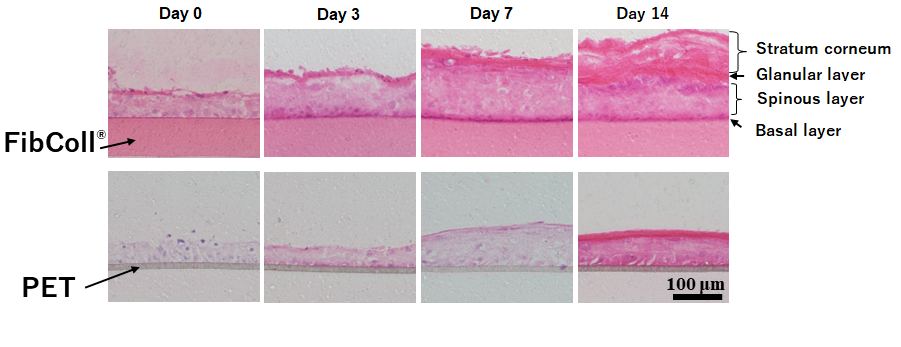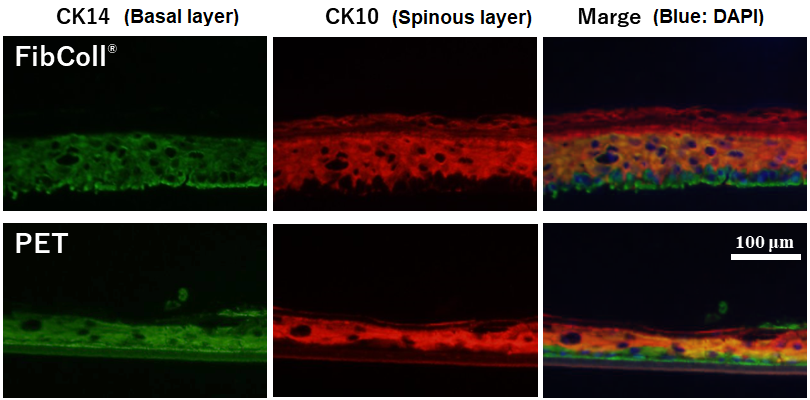| |
|
|
|
|
|
Reducing the culture time by half
Accelerated maturation of epidermal models
Note: Barrier function evaluation data are also available
|
|
|
The 3Rs principle (Reduction, Refinement, Replacement) in animal testing, which is universally accepted by researchers, was proposed by Russel and Burch in 1959. Almost half a century later, a 2003 amendment to an EU directive banned the testing of cosmetics on animals, and in 2013, an EU directive banning the marketing of animal-tested cosmetic products was enforced.
Of the 3Rs, alternative methods to animal testing have been studied to promote “Replacement,” especially in the cosmetics industry, where animal testing has been banned, and skin models consisting of cultured cells have been used. One such model is an epidermal model, in which keratinocytes are seeded on cell culture inserts and allowed to form the stratum corneum through the air-liquid interface culture.
In this article, we present data from this epidermal model using the “FibColl® Atelocollagen Insert” to demonstrate the accelerated maturation of the epidermal model.
|
|
FibColl®accelerates and thickens the stratum corneum formation in epidermal models
|
|

Keratinocytes were cultured at the air-liquid interface for 14 days under the same conditions using the FibColl® Atelocollagen Insert (FibColl®) and PET cell culture insert (PET). Frozen sections were evaluated by hematoxylin and eosin staining, and a well-developed stratum corneum was observed on FibColl® as early as day 7 of culture, and further stratification of the stratum corneum was observed on day 14.
|
|
|
FibColl® enhances the expression of stratum corneum formation markers
|
|
 |
| |
|
|
|
Keratinocytes were cultured at the air-liquid interface for 7 days on FibColl® and PET, and frozen sections were examined by fluorescent immunostaining. In FibColl®, the expression of CK14, a basal layer marker, was maximized near the basal layer. Moreover, the staining difference between CK14 and CK10, a spinous layer marker, was clearly observed. FLG, a granular layer marker, was also more pronounced in the granular layer vicinity (based on in-house data).
|
|
|
|
FibColl® improves the expression of barrier function markers and trans-epithelial electrical resistance
|
|
|
|
Furthermore, tight junctions formed by CLDN1 and the clear expression of OCLN were observed in FibColl®. In addition, trans-epithelial electrical resistance (TEER) measurements exhibited significantly higher TEER values with FibColl® compared with PET (based on in-house data).
|
|
|
|
Inserts with 100% atelocollagen membrane
|
|
|
|
FibColl® Atelocollagen Inserts 24 pieces/bag
|
|
|
Unlike other collagen-coated plastic membranes, FibColl® pores are not clogged, and the atelocollagen fiber structure enables cell culture in an in vivo mimicking environment. Now, why wouldn’t you accelerate your skin research with FibColl®?
|
|
|
|
|
|
|
|
|
|
|
|